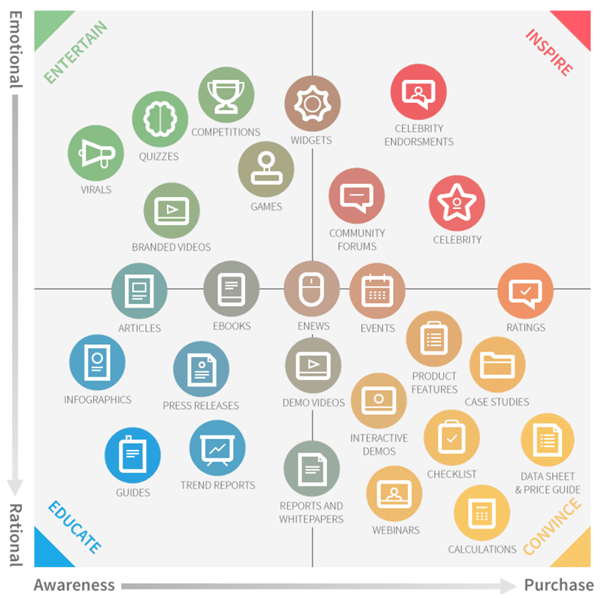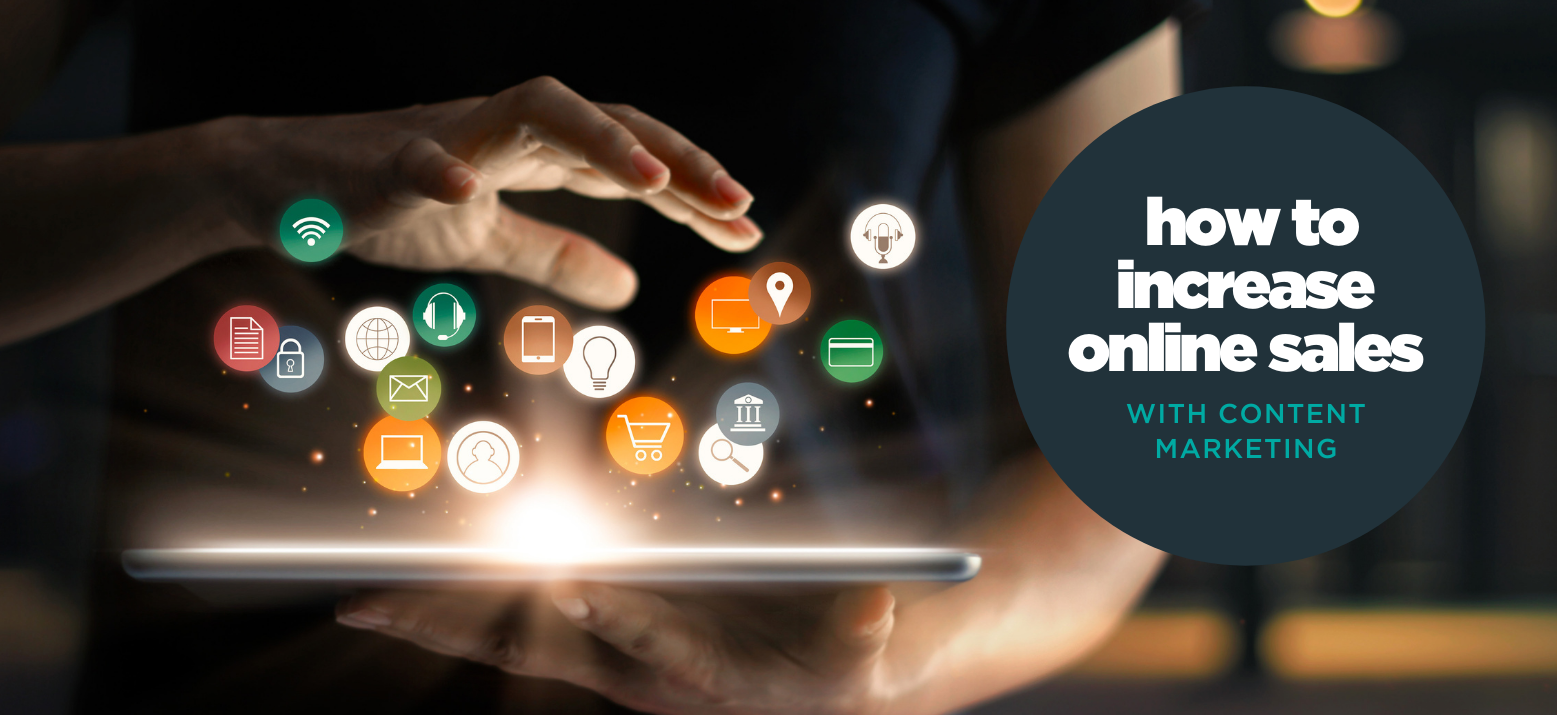The role that content plays in someone’s decision on whether or not to buy from a particular brand has long been under discussion. In the pre-Internet days, use of above the line marketing channels like TV, radio and print ads (which all incorporate ‘content’) has long correlated with sales increases along with boosting a brand’s profile and audience awareness, but it can be really tricky to accurately measure and attribute sales directly to this kind of activity.
Even these days, in comparison to marketing channels that can have a much more obvious and tangible return on investment (ROI), such as PPC or paid social, the use of other content can often be thought of as something that doesn’t directly influence conversions. However, this is most definitely a myth! Paid media is one kind of distribution for content, but by no means the only way in which content can be utilised to increase your online revenue.
How does content marketing help sales?
Effective content marketing is essentially providing your target audience with useful, inspirational, informative or entertaining information in a way that engages them wherever they are in their journey towards making a purchase. Each content element helps to move the potential customer closer to their buying decision.
This content marketing matrix graphic by Smart Insights shows some of the roles that different types of content can play in the buyer journey, and how these various tactics can potentially have an impact on sales.

As mentioned earlier, correlating the use of content in a specific marketing channel or group of channels with an increase in sales is fairly straightforward, but how do you know which pieces of content are actually achieving their goal? Any digital marketing content produced needs to be tracked and evaluated to make sure that it’s performing the role you intended so that this data can inform your future content marketing plans.
Thankfully, when it comes to ecommerce, there are many ways in which we can measure the role of digital content in driving sales, which enables you to see exactly what is working and what isn’t, along with proving the value of content to the wider success of the business. More on this later.
What should a content marketing strategy include?
No two businesses are the same, which means that your ecommerce content marketing strategy needs to be tailored to your specific brand, audience, objectives and products in order to be most effective in driving sales. Here are our five steps to focus your digital content strategy on maximising ecommerce transactions and revenue.
1. Get to know your audience better to produce more purposeful, search-optimised content
Attracting the right kind of organic traffic to your website via search engines is an essential part of any content marketing plan. The key to ensuring you bring in the right visitors with your SEO content strategy is to understand your audience and what they might be searching for at the various stages of their buyer journey. This way you can target the most appropriate intent-led keywords in your content and attract the most relevant users to your site.
This process starts with personas, and means you need to understand elements that include:
- What motivates your audience to buy what you sell?
- What/who influences their buying choices?
- What types of content do they engage with and on which platforms?
- What is likely to stop them from buying?
- What kind of information will they need to be happy to purchase?
By looking at your content marketing strategy through the eyes of your customers, and familiarising yourself with their journey and what they need at each stage to move forward, your ecommerce SEO optimised content can be shaped accordingly – to meet the requirements of shoppers whatever stage of the buying process they are at.
2. Produce content that offers something your competitors’ doesn’t
Whilst this is definitely easier said than done, taking a look at what your main competitors are doing in their content marketing plan can be a really valuable exercise to do at least every six months. Of course, every ecommerce brand has different budget constraints and varying marketing team sizes, but even with a smaller budget or available resources, it is possible to produce brilliant content that meets a genuine need in your audience and is a bit different to anything else that is out there. Take a look at this list of content that goes above and beyond, curated by Sparktoro’s Rand Fishkin, for some inspiration.
x10 content is…
“content that is 10 times better than the best result that can currently be found in the search results for a given keyword phrase or topic.” (Rand Fishkin)
Your content needs to grab and keep the attention of your target audience. But, as already mentioned, it also needs to have an objective that ties back to your core objectives of selling more products. Keeping both of these things firmly in mind will help you stay on track and make sure you’re not using valuable resources on content that won’t help drive sales.
3. Make the most of all relevant channels for every piece of content
The distribution plan for your content is as important as the content itself, because it won’t be seen by the maximum possible number of relevant potential customers unless you’ve considered how to reach them with what you’ve created.
The key word here is relevant. There’s no point using channels or platforms that aren’t in tune with what your target audience do and engage with online. However, there can often be extra reach available by using channels that aren’t necessarily an obvious first choice. For example, a tips blog post produced using your expertise in a certain area of your product niche could potentially be leveraged in a different way using digital PR to gain coverage from relevant news or media sites. Or your video content produced for a specific campaign can be utilised across paid and organic social media too with short edits ideally suited to these platforms.
Incorporate your distribution plan into your content marketing strategy from the beginning to help ensure you make the most of everything you produce.
Don’t be afraid to revisit and refresh old content too if it still has value and relevance to your audience. Pushing it out via different channels can give it a new lease of life with minimum effort required by you.
4. Optimise your CTAs and paths to sale that make it easy to buy
With ecommerce content marketing, the idea is that each content piece or asset is designed to move the potential customer further on in their journey towards a purchase, so making the next step as easy as possible for them to take is important. All content should include a call-to-action (CTA) that fits in with your objectives for this piece and makes it as straightforward as possible for people to move along that path to sale.
Looking at how converting customers are currently using your site and comparing this to those users who drop off at a late stage before completing a purchase, you can look for patterns that might indicate where some tweaks are needed. On website content, you can use A/B testing on new CTAs before setting them live permanently to ensure that the change is going to be beneficial.
5. Measure performance and adjust your strategy as needed
Measuring content marketing strategy performance is a huge topic that can’t be summarised in just a couple of paragraphs here, but the important thing is to ensure you’re tracking and evaluating the right metrics for the goals and types of activity you’re incorporating.
Obviously, your ultimate objective is more sales and revenue, so content that is designed for people at the final decision phase of their buying journey can be assessed with direct conversions in mind. For content that is aimed at potential customers earlier in the journey, you can look at how it is being engaged with, which website pages people are visiting before and after (if any) and if this lines up with the plans you made.
It’s important to give content time to work, especially if it’s focused on attracting organic traffic and/or backlinks, before making any radical decisions to base your future strategy on. However, for content used in channels that can give reliable feedback more quickly, such as with paid social content or PR coverage, you can learn from performance and ensure you tweak your strategy in the future to try and improve results and boost sales even more.
If you’d like to find out more about our approach to content marketing, get in touch with the team for a chat.







